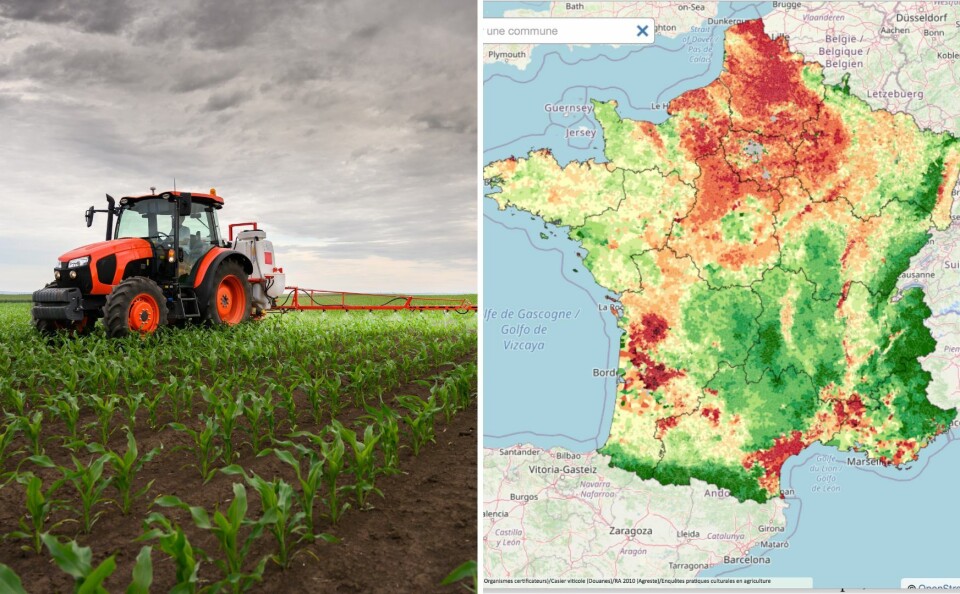-
Law proposal: commercial flights banned at night in Toulouse
Initiative seeks to reduce local noise pollution
-
Lynx warnings appear on road signs in French Alps
Purpose is to reduce collisions with the endangered species
-
French state sued over contaminated tap water
VCM contamination comes from PVC pipes installed in the 1970s and 1980s - with Dordogne the most affected department
Pesticide no-spray zones in France ‘not enough to keep us safe’
Campaigners say the five to 10 metre buffers should be extended to 100 metres to reduce the risk to health

An interactive map showing pesticide use across France has reignited debate over whether country dwellers are sufficiently protected.
The map, created by agroecological organisation Solagro, highlights the extent of France’s reliance on pesticides, particularly in the north and in the vineyards of the south west.
Read more: MAP - See level of pesticide use in your area of France
Campaigners say no-spray zones not big enough
In 2019, the government introduced minimum distances between homes and farmland where pesticides are used.
These zones de non traitement (ZNT) are 20 metres for the most dangerous products, or 10 metres for taller crops such as fruit trees and vines, and five metres for everything else.
This followed a long campaign by environmentalists, who maintain the new rules do not go far enough.
Nadine Lauverjat, of environmental defence association Générations Futures, told The Connexion: “We didn’t obtain the real protection we hoped for.”
Government could be moving goalposts
In July 2021, the Conseil d’Etat gave the government six months to increase the distance to at least 10 metres for products currently only suspected of being carcinogenic, mutagenic or toxic.
The government instead asked the national agency for food, environmental and occupational health and safety (Anses) to review the categorisations of different pesticides before increasing the distance from this October.
‘Risk to vulnerable only decreases after 100 metres’
Générations Futures is demanding the zones are extended to 100 metres, having published two studies in the past year which tested for the presence of pesticide residue, and found this only decreased significantly 100 metres from farmland.
They argue that the risk evaluation behind the five to 20 metre zones did not consider the impact on foetuses, children, adolescents or immunocompromised people.
Agricultural workers most at risk
Ms Lauverjat explained that locals risk coming into contact with pesticides in several ways: while they are being sprayed; in warm weather, which causes them to reevaporate and scatter after being sprayed; consuming fruits and vegetables from their gardens; and young children touching leaves with pesticide residue to their mouths.
Most at risk are the agricultural workers who handle the chemicals.
Strong link with with workers’ illness
Last year, Inserm, the French national institute of health and medical research, published a report analysing the latest scientific literature, which confirmed “a strong presumed link between occupational exposure to pesticides and four diseases: non-Hodgkin lymphomas, multiple myeloma, prostate cancer, and Parkinson’s disease”.
It also highlighted links to cognitive disorders, depression, and Alzheimer’s disease.
Study started in wine regions
The effect on local residents is more difficult to prove. However, Santé Publique France and Anses have begun a vast study into the presence of pesticides in wine-producing regions.
The PestiRiv study will compare the presence of pesticides in the air, dust, urine, hair, and garden fruits and vegetables, between people living close to vineyards and those living further away. The results will be published in 2024.
Union say modern farming techniques are the answer
Any attempt to strengthen the regulations is likely to be met with fierce opposition from agricultural workers, hundreds of whom protested in December when the deadline for the government to enhance its protections was coming to an end.
Hervé Lapie, chief administrative officer of the FNSEA, France’s largest farmers’ union, accused authorities of setting the distances based on outdated agricultural practices.
“The real question is which techniques allow for a drift equal to zero,” he told The Connexion.
He said farmers are reliant on pesticides to meet strict food standards regulations, “otherwise we’d be the first to do without them”.
People choose to live near farmland
“We continue to say there must be investment in genetics to have plants which are more resistant to disease.”
He says extending ZNTs would have serious repercussions, particularly in regions where farmland is broken up by second homes and other properties.
“Urbanisation is eating away at agriculture. Every year we lose agricultural land,” he said.
“When people come to live in the countryside, we need to explain to them that when you live near agricultural land, it brings a bit of noise and dust, and that they need to be able to accept certain constraints.”
The FNSEA has previously called for compensation for farmers whose land falls within a ZNT, although Ms Lauverjat insisted a ZNT is “not a distance without crops, but a zone without treatment”.
Weedkiller also controversial
The zones are seen as one solution to a question which has preoccupied Europe for several years.
President Macron said he would ban glyphosate, possibly the most controversial herbicide on the market, by 2021, a promise he later abandoned.
The weedkiller’s EU approval runs out in mid-December, but the bloc is likely to extend this until July the following year, when the European Food Safety Authority is due to publish its recommendation.
Related articles
French farmer grows crops without water, fertiliser or pesticide
France bans pesticide use in more places, including private residences
France one of EU’s worst culprits for pesticide-grown fruit and veg
























